Intel Launches 35W Tiger Lake Quad Core H35 Processors for New ‘Ultraportable Gaming’ Segment
Intel announced four new 11th-Gen Tiger Lake H-Series processors at CES 2021, but they aren't the eight-core 45W models we expected. Instead, Intel has developed quad-core Tiger Lake 'H35' chips with a 35W TDP and defined a new laptop segment, dubbed "ultraportables," to house them. These chips will serve as the alternative to AMD's potent Ryzen Mobile processors, which have steadily gained ground over the last year.
Up to 40 new designs with the H35 chips will come to market this year, with several being launched today at CES. Intel also announced that it has collaborated with Nvidia to add support for Resizable BAR, a feature that boosts GPU performance, to the new ultraportable laptops.
For now, Intel's new flagship Tiger Lake chip comes as the four-core eight-thread Core i7-11375H Special Edition that can boost up to 5.0 GHz on a single core and up to 4.3 GHz on all cores. Intel says its long-awaited eight-core 45W H-series chips are still in development, with headline specs including a 5.0 GHz boost on multiple cores, but the company's first eight-core 10nm processors won't come to market until later this quarter.
| PROCESSOR | CORES/THREADS | GRAPHICS (EUs) | OPERATING RANGE (W) | BASE CLOCK (GHZ) | SINGLE CORE TURBO FREQ (GHZ) | MAXIMUM ALL CORE FREQ (GHZ) | Cache (MB) | GRAPHICS MAX FREQ (GHZ) | MEMORY |
|---|---|---|---|---|---|---|---|---|---|
| Core i7-11375H Special Edition | 4C / 8T | 96 | 28 - 35W | 3.3 (35W) / 3.0 (28W) | 5.0 (with TB3) | 4.3 | 12 | 1.35 | DDR4-3200, LPDDR4x-4266 |
| Core i7-11370H | 4C / 8T | 96 | 28 - 35W | 3.3 (35W) / 3.0 (28W) | 4.8 | 4.3 | 12 | 1.35 | DDR4-3200, LPDDR4x-4266 |
| Core i5-11300H | 4C / 8T | 80 | 28 - 35W | 3.1 (35W) / 2.6 (28W) | 4.4 | 4.0 | 12 | 1.3 | DDR4-3200, LPDDR4x-4266 |
| Core i7-1185G7 (UP3) | 4C / 8T | 96 | 12 - 28W | 3.0 | 4.8 | 4.3 | 12 | 1.35 | DDR4-3200, LPDDR4x-4266 |
| Core i7-1165G7 (UP3) | 4C / 8T | 96 | 12 - 28W | 2.8 | 4.7 | 4.1 | 12 | 1.30 | DDR4-3200, LPDDR4x-4266 |
| Core i5-1135G7 (UP3) | 4C / 8T | 80 | 12 - 28W | 2.4 | 4.2 | 3.8 | 8 | 1.30 | DDR4-3200, LPDDR4x-4266 |
| Core i3-1115G4 (UP3) | 2C / 4T | 48 | 12 - 28W | 3.0 | 4.1 | 4.1 | 6 | 1.25 | DDR4-3200, LPDDR4x-3733 |
The three new Tiger Lake H35 processors feature the 10nm SuperFin process and Tiger Lake architecture, so the H35 feature set is mostly the same as the 28W (UP3) processors already on the market. However, while the UP3 models have a configurable TDP that spans from 12 to 28W, the new models can operate at either 28W or 35W. Naturally, the higher-TDP rating allows Intel to dial up the clock speeds to extract a bit more performance from the chips.
The Core i7-11375H H35 Special Edition leads the new lineup with up to a 5.0 GHz boost frequency on a single core. Notably, this is a Turbo Boost Max feature, meaning the 5.0 GHz boost will apply to one physical core only. The chip can also reach up to 4.8 GHz on two cores, and 4.3 GHz on all four cores. As you would expect, boost frequency and duration will depend upon each laptop’s thermal capabilities.
Intel's Core i7-11370H and i5-11300H slot in beneath the flagship, both with four cores and eight threads. The primary difference between these two chips boils down to clock speeds and cache capacity. Naturally, the i5 model has lower clocks, but it also comes with only 8MB of cache compared to the 12MB found on the two Core i7 models.
The chips feature the Xe LP graphics architecture found in the current Tiger Lake models, with similar peak clock frequencies as the existing quad-core models. Both Core i7 models come equipped with 96 EUs, just like the flagship 28W model, while the Core i5 variant comes with 80 EUs.
Get Tom's Hardware's best news and in-depth reviews, straight to your inbox.
Intel is adopting the same Resizable BAR technology, a standard capability of the PCIe interface, that AMD adopted with its Ryzen 5000 CPUs and Radeon 6000 series GPUs (dubbed Smart Access Memory). Nvidia also recently joined the Resizable BAR party, announcing that it will support the feature shortly after AMD, and has worked with Intel to enable that same feature with its next-gen GPUs that will power the H35 and future Tiger Lake platforms. This feature promises to boost gaming performance, and it appears that Intel will be the first to bring the tech to the laptop market.
We're curious to see how this plays out for the quad-core Tiger Lake chips, which apparently only have an x4 PCIe link for dedicated graphics cards or SSDs. Will resizable BAR help more with a narrower link width, or will it make less of a difference? This is something we'll test once we have hardware in hand.
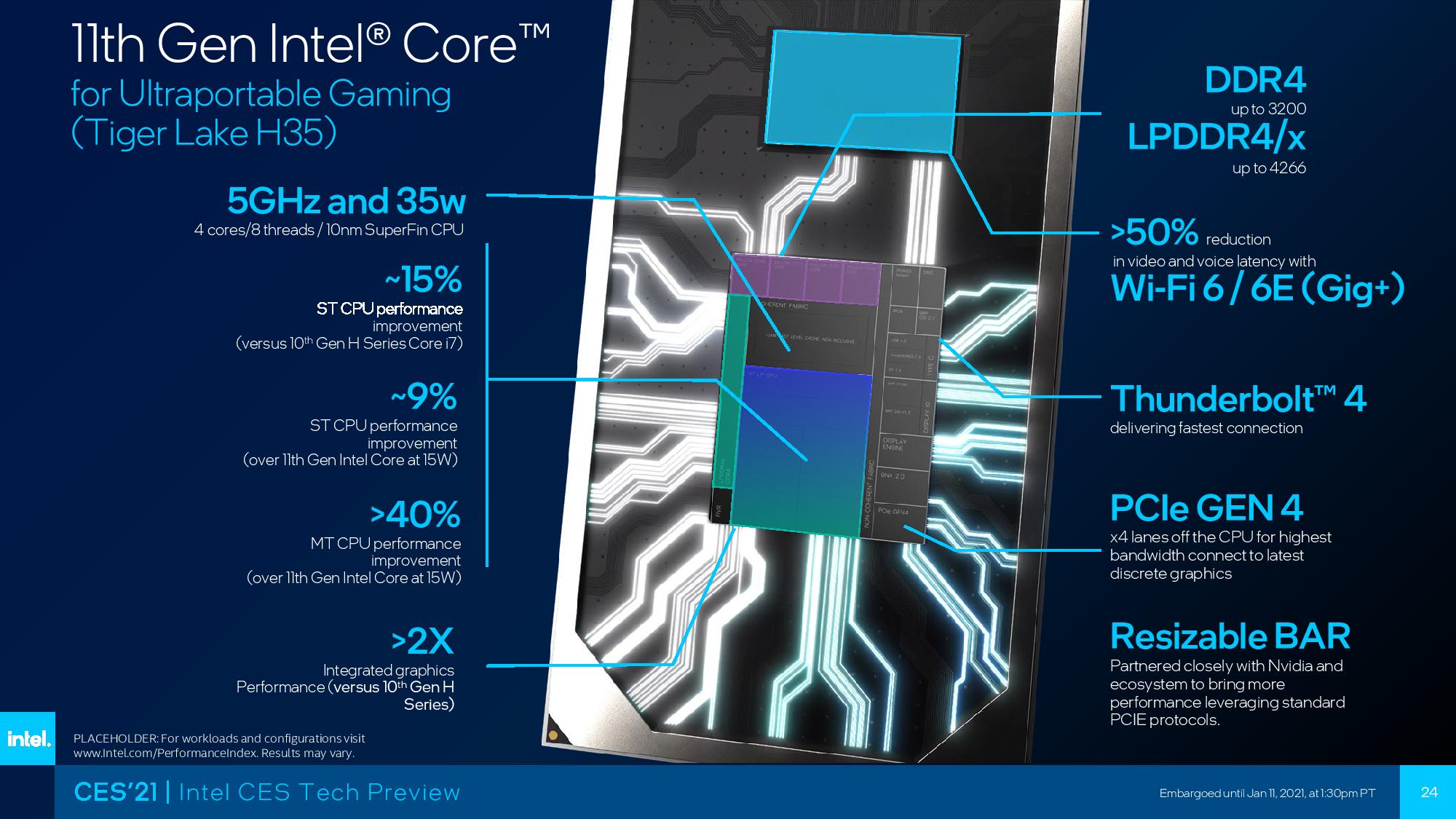
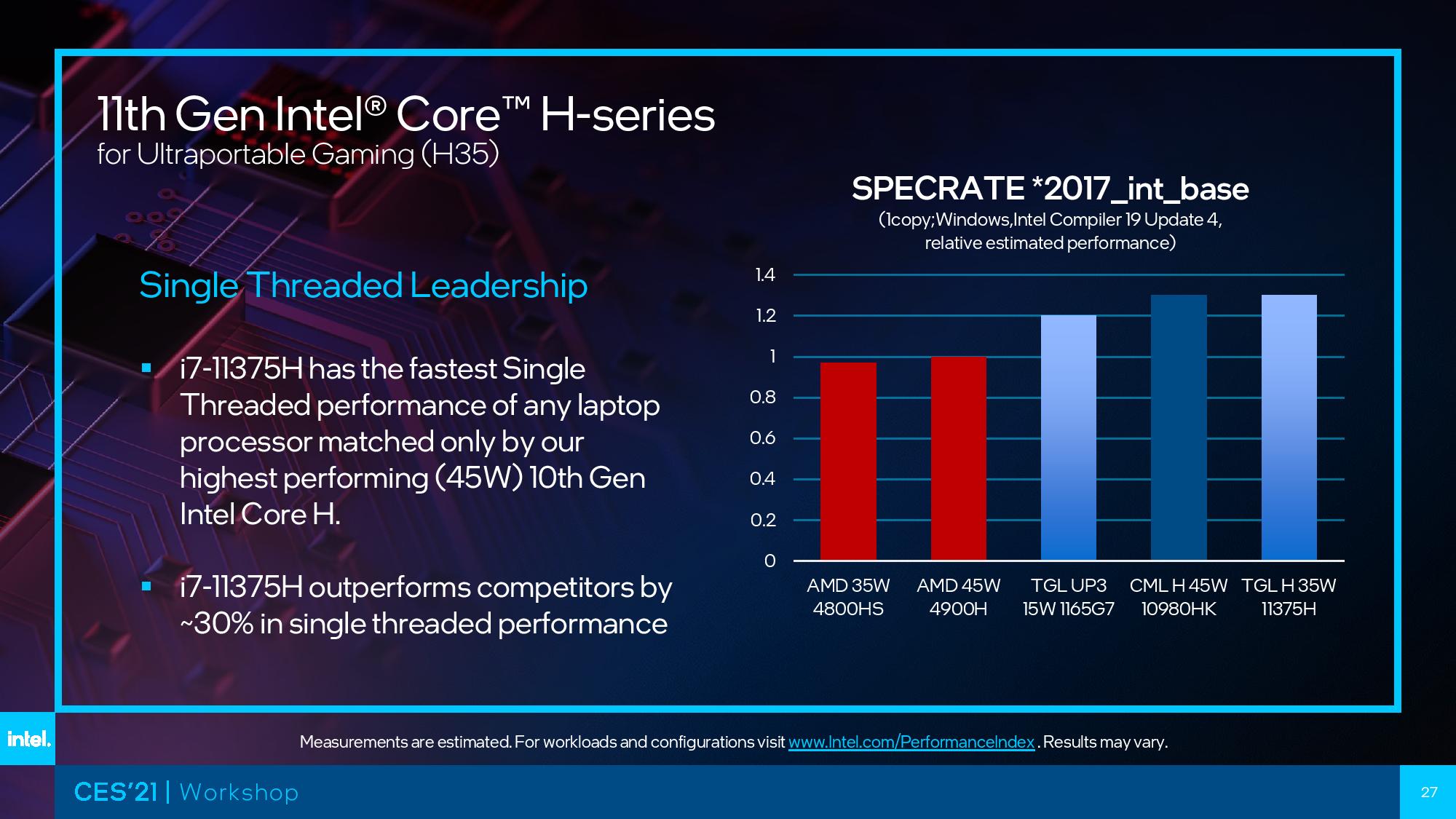
Intel provided a few benchmarks for the new chips, but as with all vendor-provided benchmarks, take them with a grain of salt. Here we see that Intel compared the existing quad-core i7-1165G7 to the new i7-11375H chip to derive the performance claims in the second slide in the album. That slide says the processor offers 9% more performance than the 1165G7, but Intel tested the latter at 15W. The 1165G7 has a configurable TDP that allows it to run at 28W, which the company tells us shrinks the lead for the new H35 chip to 4%.
Intel also based these performance projections on an integer workload, which it says is more representative of consumer workloads than the floating-point test that tends to be more demanding (particularly in terms of thermals and peak clock speeds). Intel says it will share the floating point benchmarks, which we'll add when we receive them. Intel also isn't sharing gaming performance projections yet, citing an NDA for Nvidia's next-gen mobile GPUs.
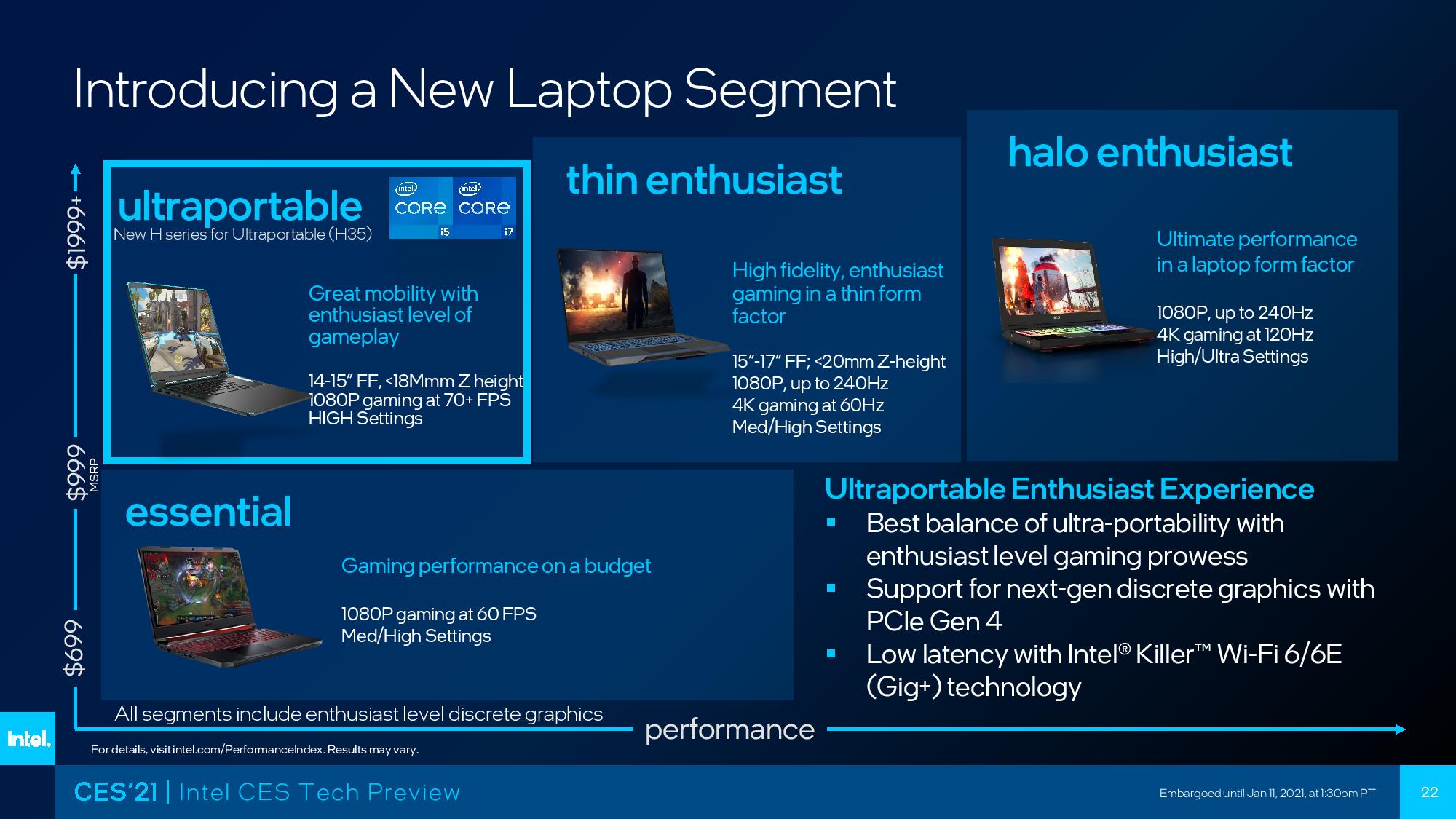
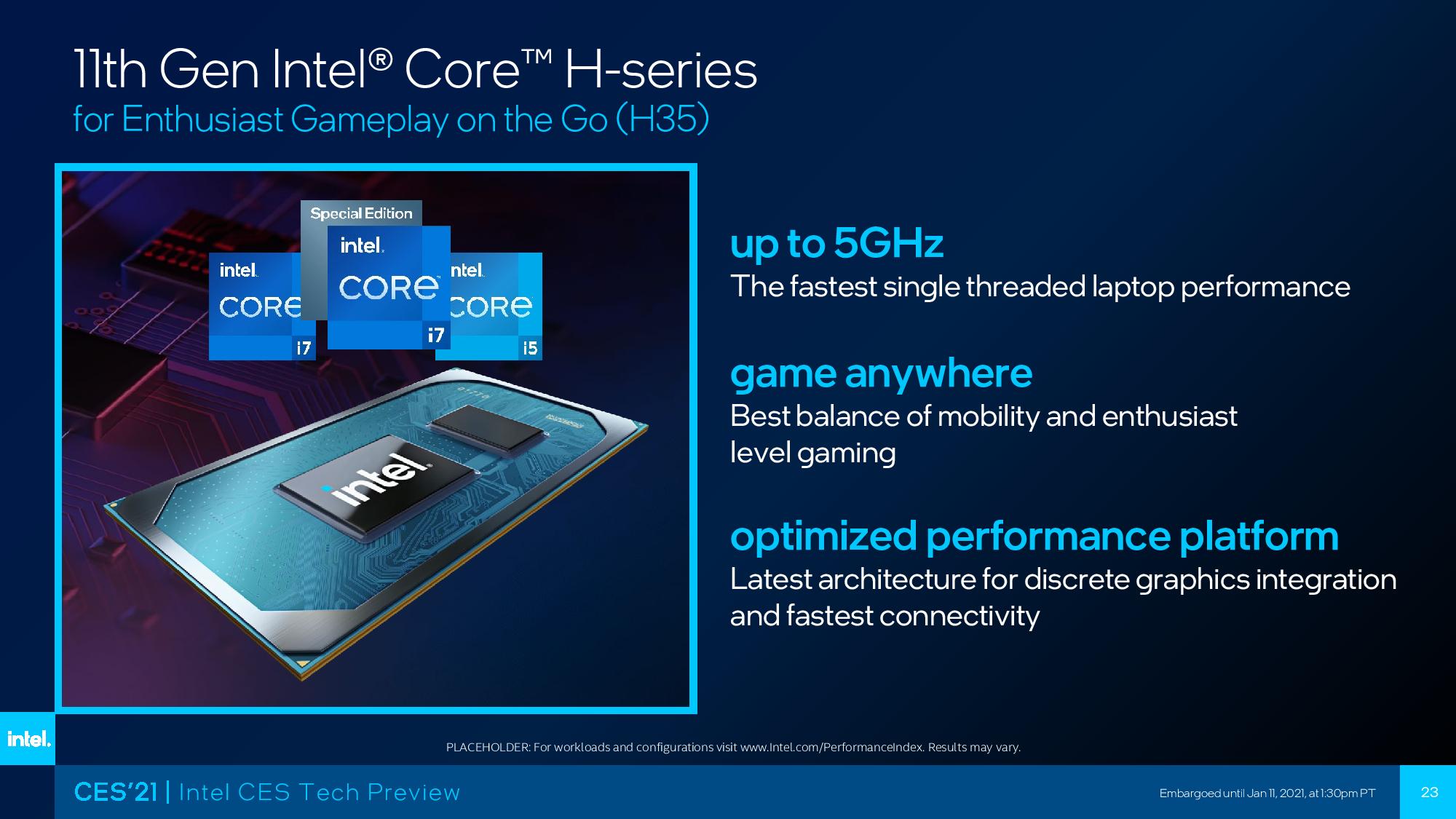


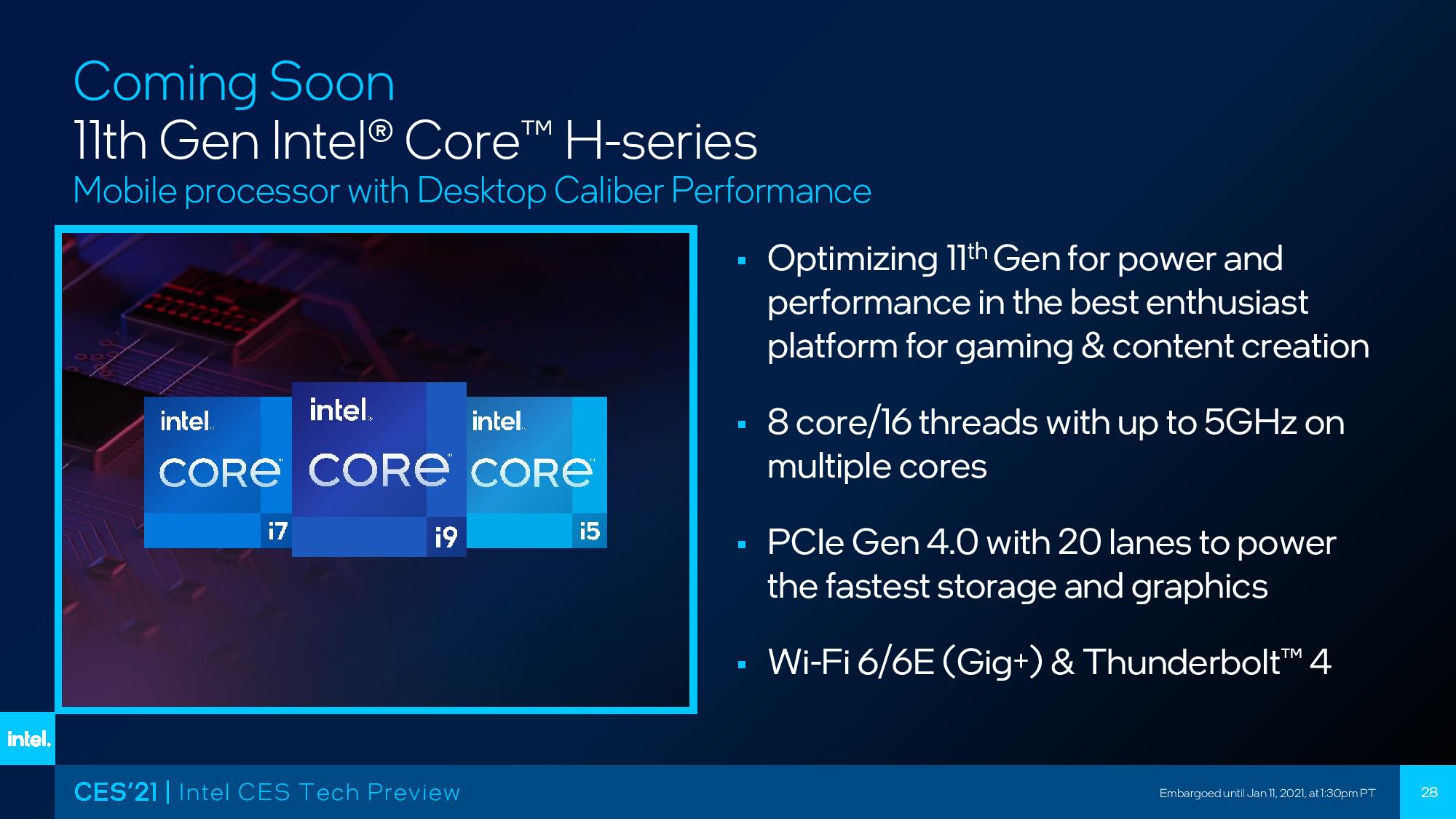
The destination for the chips? A newly-defined ultraportable segment that consists of thin-and-light laptops designed for enthusiast-level gameplay. These laptops will come in 14" and 15" form factors with a maximum thickness of 18mm. Intel has set a 1080p gaming performance goal for the new designs — they should achieve 70 fps (or higher) at high fidelity settings. Intel says that its partners have 40 new designs based on the chips coming to market in the first half of 2021, including designs launched at CES by Acer, Asus, MSI, and Vaio. Intel hasn't released any firm battery life projections compared to the existing Tiger Lake chips, but given the higher TDP range, we don't expect an improvement.
New platforms based on these chips will arrive to market over the coming months, with more than 40 devices planned. In the meantime, we await the full-fledged 45W eight-core Tiger Lake processors that are still under development. Intel did provide a demo showing a future eight-core Tiger Lake chip running a 4K gaming session with 'desktop caliber' gaming performance at its event, so the company is apparently bullish on the performance front. That will be a needed addition to fend off AMD's Ryzen Mobile processors.
In the interim, Intel's Comet Lake 10th Gen processors will still soldier on as the eight-core vanguard of Intel's laptop fleet, with the recently-added 45W Comet Lake Core i7-10870H and Core i5-10500H serving as the eight-core mainstays while Intel awaits its 45W Tiger Lake models.

Paul Alcorn is the Editor-in-Chief for Tom's Hardware US. He also writes news and reviews on CPUs, storage, and enterprise hardware.
-
Xajel So they still believe that gaming can't go beyond quad core.. BS. It's 10nm is just isn't ready to go for larger dies for now, they need more time for that 8C parts to come, and maybe along with it they might be able to bring a special edition version that work at 35W while still bringing high boost clocks.Reply -
spongiemaster Reply
You really think the quad core CPU is going to be the limiting factor when gaming on an ultra portable with an IGP at 1080p or higher?Xajel said:So they still believe that gaming can't go beyond quad core.. BS. It's 10nm is just isn't ready to go for larger dies for now, they need more time for that 8C parts to come, and maybe along with it they might be able to bring a special edition version that work at 35W while still bringing high boost clocks.